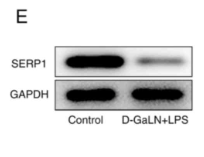SERP1 Antibody - #DF9873
| Product: | SERP1 Antibody |
| Catalog: | DF9873 |
| Description: | Rabbit polyclonal antibody to SERP1 |
| Application: | WB IHC IF/ICC |
| Reactivity: | Human, Mouse, Rat |
| Prediction: | Pig, Bovine, Rabbit, Chicken |
| Mol.Wt.: | 7 kDa; 7kD(Calculated). |
| Uniprot: | Q9Y6X1 |
| RRID: | AB_2843067 |
Related Downloads
Protocols
Product Info
*The optimal dilutions should be determined by the end user.
*Tips:
WB: For western blot detection of denatured protein samples. IHC: For immunohistochemical detection of paraffin sections (IHC-p) or frozen sections (IHC-f) of tissue samples. IF/ICC: For immunofluorescence detection of cell samples. ELISA(peptide): For ELISA detection of antigenic peptide.
Cite Format: Affinity Biosciences Cat# DF9873, RRID:AB_2843067.
Fold/Unfold
D3Ucla1; Ramp4; Ribosome associated membrane protein 4; Ribosome attached membrane protein 4; Ribosome-attached membrane protein 4; Serp1; SERP1_HUMAN; Stress associated endoplasmic reticulum protein 1; Stress-associated endoplasmic reticulum protein 1;
Immunogens
- Q9Y6X1 SERP1_HUMAN:
- Protein BLAST With
- NCBI/
- ExPASy/
- Uniprot
MVAKQRIRMANEKHSKNITQRGNVAKTSRNAPEEKASVGPWLLALFIFVVCGSAIFQIIQSIRMGM
Predictions
Score>80(red) has high confidence and is suggested to be used for WB detection. *The prediction model is mainly based on the alignment of immunogen sequences, the results are for reference only, not as the basis of quality assurance.
High(score>80) Medium(80>score>50) Low(score<50) No confidence
PTMs - Q9Y6X1 As Substrate
| Site | PTM Type | Enzyme | Source |
|---|---|---|---|
| K16 | Ubiquitination | Uniprot | |
| R21 | Methylation | Uniprot | |
| K26 | Ubiquitination | Uniprot | |
| S37 | Phosphorylation | Uniprot |
Research Backgrounds
Interacts with target proteins during their translocation into the lumen of the endoplasmic reticulum. Protects unfolded target proteins against degradation during ER stress. May facilitate glycosylation of target proteins after termination of ER stress. May modulate the use of N-glycosylation sites on target proteins (By similarity).
Membrane>Single-pass type IV membrane protein. Endoplasmic reticulum membrane>Single-pass membrane protein>Cytoplasmic side.
Interacts with SEC61B, SEC61A1 and the SEC61 complex. Interacts with CANX (By similarity).
Belongs to the RAMP4 family.
References
Application: WB Species: Mouse Sample:
Restrictive clause
Affinity Biosciences tests all products strictly. Citations are provided as a resource for additional applications that have not been validated by Affinity Biosciences. Please choose the appropriate format for each application and consult Materials and Methods sections for additional details about the use of any product in these publications.
For Research Use Only.
Not for use in diagnostic or therapeutic procedures. Not for resale. Not for distribution without written consent. Affinity Biosciences will not be held responsible for patent infringement or other violations that may occur with the use of our products. Affinity Biosciences, Affinity Biosciences Logo and all other trademarks are the property of Affinity Biosciences LTD.

